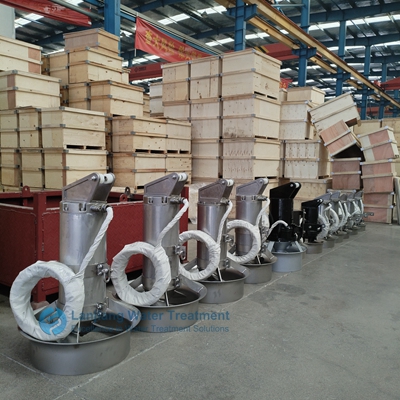The mixing speed of sewage mixer is a key parameter, which directly affects the mixing effect and sewage treatment efficiency. Regarding the mixing speed of the sewage mixer, it can be elaborated from the following aspects:
First, speed range
The speed of the sewage mixer is usually within a certain range, which is designed to ensure the mixing effect while avoiding adverse effects on the equipment and process. In general, the speed of the sewage mixer should be between 1.0 and 2.5m/s. However, this speed range is not absolute and may vary depending on the type of mixer, the nature of the wastewater and the treatment process.

Second, the effect of speed on mixing effect
1. Too fast speed: If the mixer speed is too fast, it will make the sewage spray, resulting in a large amount of air into the water, which may destroy the ecological balance of microorganisms and affect the biological treatment effect.
2. The speed is too slow: the stirring speed is too slow, the sludge may be attached to the mixer, affecting the mixing effect, and it may also lead to sludge deposition and reduce the treatment efficiency.
Third, speed selection basis
When choosing the mixing speed of the sewage mixer, the following factors need to be considered:
1. Sewage properties: Different types of sewage have different requirements for mixing speed. For example, sewage with a high concentration of suspended solids may require a higher stirring speed to ensure a uniform dispersion of suspended solids.
2. Treatment process: Different sewage treatment processes have different requirements for mixing effects. Therefore, when choosing the mixing speed, it needs to be determined according to the specific treatment process.
3. Mixer type and size: Different types of agitators (such as propulsion, paddle, anchor, etc.) and size have different requirements for mixing speed. In general, a large mixer may require a lower speed to achieve the desired line speed, while a small mixer may require a higher speed.
Fourth, other precautions
1. Equipment wear: After a long time of operation, the mixer may be worn, resulting in a decline in mixing effect. Therefore, it is necessary to check and maintain the mixer regularly to ensure that it is in good working condition.
2. Energy consumption control: Under the premise of ensuring the mixing effect, the mixing speed should be reasonably controlled to reduce energy consumption. Too high stirring speed will increase energy consumption costs, while too low stirring speed may not achieve the desired stirring effect.
In summary, the mixing speed of the sewage mixer is a parameter that needs to be selected and adjusted according to the specific situation. In practical application, it is recommended to determine the best stirring speed range according to the characteristics of sewage, treatment technology, type and size of agitator and other factors. At the same time, it is also necessary to pay attention to the wear and energy consumption control of the equipment to ensure the efficient and stable operation of the sewage treatment process.
Post time:2024-07-07